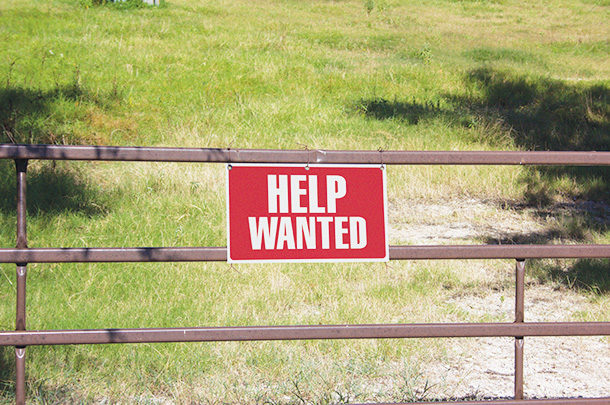“Help wanted,” “now hiring,” “open positions,” “accepting applications,” “open interviews,” “apply inside.” Sound familiar? It sure does to me. Nationwide, nearly every industry is feeling the pinch for employees.
According to recent labor data, there are 3.5 million fewer people employed than two years ago, pre-pandemic. Yet only half that number are seeking jobs, leading to the current labor imbalance. The labor shortage issue is complicated.
However experts explain it, there is only one conclusion: Employees are in the driver’s seat in this labor market. Business Insider explains the situation by saying, “The labor market is undergoing structural, worker-driven change.”
In agriculture, we are no stranger to labor issues. Agriculture has struggled with farm labor shortages for the better part of a generation. According to USDA data, since 1950, there has been a 52% decline in hired farmworkers and a 73% decline in family farmworkers. Now, in 2022, the economy-wide labor struggles are exacerbating the issue. Not only are we struggling to recruit new employees, we are struggling to retain our long-term employees. The question is: How do farmers and ranchers survive in an economy that is “undergoing structural, worker-driven change?”
The answer is: We need to be better employers.
Bob Milligan, senior consultant with Dairy Strategies LLC and professor emeritus from Cornell University, says, “We have always been creative growing crops and raising cattle. Today, we have got to use that creativity to create good jobs for our employees.” By saying this, Milligan is switching the narrative we hear about farm labor. It’s on us, not the economy or farm policy, to solve our labor needs. By creating desirable jobs for employees, we make sure we have the help we need.
Let’s talk about how we become better employers.
Compensation – are you paying enough?
According to data from the Bureau of Labor Statistics, the median salary in 2020 for agricultural workers was $13.89 per hour or $28,900 annually. What you pay your employees will vary widely by location, type of job, seasonality of the employment and commodity within agriculture. However, the data does give you a benchmark to start your analysis from. Compare your hourly wages against competing industries in your region, like construction and hospitality, as well as the median labor salary.
Jeffrey Tranel, agricultural economist with Colorado State Extension, recommends considering all types of compensation beyond just wages. He says, “Farmers and ranchers need to understand what motivates their employees to get the desired performance from their workers. The relationship between wages paid and results is not necessarily a given. It can be strongly shaped on how compensation is structured and administered.”
The general manager of Maddux Cattle Company in Wauneta, Nebraska, Robert Brosius, says, “With our employees, we try to take money off the table. We do our best to offer a competitive salary, so the money isn’t a concern. But we also offer a good benefits package, with 401K, health insurance, cellphone and housing. If they are focusing on the cattle, not the money, the ranch is better off.”
Once you’ve considered wages, consider the other benefits you offer (or don’t offer) in terms of total compensation. Tranel says, “It’s very common for agricultural producers to compensate their employees with benefits in addition to regular wages. Commodities, housing, personal use of business assets and clothing are all non-cash fringe benefits.” When looking at the “benefits package” you offer your employee, here are a few other things to consider.
‘Benefits package’ to consider for your employees
- Health insurance
- Retirement
- Cellphone
- Paid time off
- Sick leave
- Ranch vehicles, like truck and trailer
- Housing
- Work clothing stipend or branded clothing
- Commodities, like half a beef or feed for working personal animals
- Farrier stipend
- Flexibility to train outside horses and dogs
- Ability to run personal cattle
- Day work for spouse
- Flexibility with family time
- Continuing education
Your company culture
We often don’t think about company culture in production agriculture. Especially since many operations have few (if any) non-family employees, it has enormous implications for your ability to recruit and retain good employees. What the media is calling the “Great Resignation” in corporate America has nearly everything to do with a mismatch between company culture and employees’ values. You directly shape company culture and make your farm or ranch a good place to work as an employer.
Logan Pribbeno of Wine Glass Ranch in Imperial, Nebraska, says, “It’s hard waiting on culture; it’s not something that changes overnight. I inherited a culture that was OK but not great. I knew it would not take us to the future. I changed the culture of the ranch, but it took a long time for the culture to change the business. In agriculture, we are used to one-year systems: one crop a year, one calf a year. The culture won’t change that way; you start to change stuff, and our systems can be slow to reflect those changes.”
How do you change your company culture? Pribbeno recommends simply talking to your employees. You might just be surprised at their insight. He says, “We do yearly annual reviews with each employee. When I first came back to the ranch, I thought the employees didn’t like the reviews, but the feedback was the exact opposite. Employees cherish the ability to talk about themselves for a full hour with their manager. It was a paradigm shift for me, and it helped as I worked to change the culture.”
Brosius says about the Maddux company culture, “We do our best to provide our employees freedom and autonomy. In day-to-day business, employees are making the management decisions within their herd. The company sets the vision, the goals and the protocols. We expect the employees to follow those, but there is no micro-management.”
Things to consider about your culture:
- Job satisfaction
- Employee recognition
- Responsibility
- Job growth
- Autonomy
- Flexibility
- Manager and employee interaction
- Employee and employee interaction
- Advancement opportunities
- Training and education
You are competing with other industries for employees, and that competition is fierce. Until we figure out how to raise beef cattle virtually, that competition will remain. The best way to not worry about labor shortages in agriculture is not to have a labor shortage in your operation. That means switching the narrative and creating good jobs for your employees. You do this by compensating competitively, providing a benefits package and creating a company culture that makes people want to stick around.









